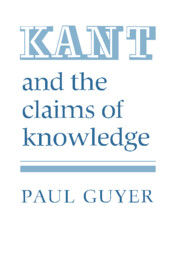Book contents
- Frontmatter
- Contents
- Acknowledgments
- Note on sources
- Introduction
- Part I Kant's early view
- Part II The transcendental deduction from 1781 to 1787
- Part III The principles of empirical knowledge
- Part IV The refutation of idealism
- 12 The problem, project, and premise of the refutation
- 13 The central arguments of the refutation
- 14 The metaphysics of the refutation
- Part V Transcendental idealism
- Afterword
- Notes
- Index of passages cited
- General index
13 - The central arguments of the refutation
Published online by Cambridge University Press: 09 March 2010
- Frontmatter
- Contents
- Acknowledgments
- Note on sources
- Introduction
- Part I Kant's early view
- Part II The transcendental deduction from 1781 to 1787
- Part III The principles of empirical knowledge
- Part IV The refutation of idealism
- 12 The problem, project, and premise of the refutation
- 13 The central arguments of the refutation
- 14 The metaphysics of the refutation
- Part V Transcendental idealism
- Afterword
- Notes
- Index of passages cited
- General index
Summary
We shall now consider the two forms of argument just proposed. First we shall examine Kant's argument that the representation of succession in time requires the representation of space, which in turn involves the existence of enduring objects distinct from the self and its representations. This argument will be more elaborate than any of the hints in that direction included in the Critique, but ultimately no more successful. Then we shall consider Kant's argument that subjective successions can be made determinate only if they are regarded as caused by objects conceived to exist independently of the self and its states, which are represented as spatial precisely because that is how we can represent the independence we ascribe to them. This argument will represent nothing less than Kant's final attempt to solve the puzzle about the objective validity of the a priori concepts of understanding first discovered in 1772.
Displaying time in space
As we saw, neither the refutation of 1787 nor the first analogy contains any obvious ground for the conclusion that an enduring object must be spatial, and Kant's attempt to reach this further conclusion in the second note to the refutation (B 277–8) and the “General Note” rests on the undefended assertion that the empirical intuition of motion in space is necessary to measure or even to represent succession in time. One of Kant's tactics in the subsequent years was clearly to attempt a direct argument to the necessity of space for time-determination which would remove the arbitrariness of these earlier suggestions and, indeed, obviate the difficulty of having to establish the connection between time-determination and endurance as a prior step of the argument.
- Type
- Chapter
- Information
- Kant and the Claims of Knowledge , pp. 297 - 316Publisher: Cambridge University PressPrint publication year: 1987



